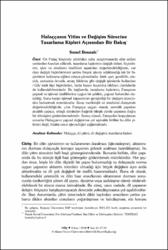| dc.contributor.author | Bosnalı, Sonel | |
| dc.date.accessioned | 2022-05-11T14:29:36Z | |
| dc.date.available | 2022-05-11T14:29:36Z | |
| dc.date.issued | 2010 | |
| dc.identifier.issn | 1301-0549 | |
| dc.identifier.uri | https://app.trdizin.gov.tr/makale/TWpBeU9EZzBOQT09 | |
| dc.identifier.uri | https://hdl.handle.net/20.500.11776/7055 | |
| dc.description.abstract | On Halaç köyünde yürütülen saha araştırmasında elde edilen verilerden hareket edilerek, tasarlama kiplerinin değişik türleri, biçimbirim, işlev ve sözdizimi özellikleri açısından değerlendirildiğinde, var olan değişik biçimbirimleri yerine birçok işlevin odaklandığı tek bir biçimbirim kullanımı eğilimi ortaya çıkmaktadır. İstek, şart, gereklilik, olasılık, zamanda öncelik, amaç bildirme gibi değişik işlevlerde kullanılan /-GA/ istek kipi biçimbirimi, hatta bazen buyurma bildiren cümlelerde de kullanılabilmektedir. Bu bağlamda, tasarlama kiplerinin, Farsçanın yapısal ve işlevsel özelliklerine uygun bir şekilde, yapısal bakımdan daraldığı, buna karşın işlevsel kapsamının genişlediği bir değişim sürecinden bahsetmek mümkündür. Konu morfolojik ve sözdizimi düzeyinde değerlendirildiğinde, yine Farsçaya uygun olarak, sentetik yapıdan analitik yapıya, ortaçlı cümleden bağımlı bileşik cümle yapısına doğru bir dönüşüm gözlemlenmektedir. Sonuç olarak, Farsçadan kopyalanan unsurlar Halaççanın yapısal değişimine yol açmakla birlikte bu dilin yitimini değil, bilakis onun işlevselliğini sağlamaktadır. | en_US |
| dc.description.abstract | This article is based on a study of the Khalaj language through data gathered from fieldwork conduct in ten Khalaj villages in Iran. The study is an examination of the Khalaj language in terms of its intentional mood and structure. In the article different kinds of gram-matical moods are evaluated in terms of morphological, functional and syntactical features. These features are examined in terms of the rela-tionship between Khalaj and Persian. The study shows that there is a tendency for the usage of only one morphology type, upon which many functions focus. As such, the subjunctive mood /-GA/ used for numerous functions; namely the subjunctive, the conditional, to ex-press a necessity, probability, priority in time and as an indicative of purpose can all be used as imperative sentences. This leads us to the conclusion that there has been an evolution in the grammatical moods, resulting in similar patterns to grammatical moods in the Farsi language both in terms of structure and function. As in Farsi, Khalaji has undergone a process of change, whereby it has become structur-ally narrow, but functionally wider. When the subject is examined on the morphological and syntactical level, again in conformity with the Farsi language, one can note a transformation from a synthetical to an analytical structure and a change from sentences with adjective parti-ciples to the correlative sentence. Consequently, it can be stated that the grammatical features which are borrowed from the Farsi language are leading to structural changes in the Khalaji language, but far from resulting in its loss, these adaptations are permitting its continued func-tionality. | en_US |
| dc.language.iso | tur | en_US |
| dc.rights | info:eu-repo/semantics/openAccess | en_US |
| dc.title | Halaççanın Yitim ve Değişim Sürecine Tasarlama Kipleri Açısından Bir Bakış | en_US |
| dc.title.alternative | An Examination of the Change and Possible Extinction of the Khalaj Language in Terms of Intentional Moods | en_US |
| dc.type | article | en_US |
| dc.relation.ispartof | Bilig / Türk Dünyası Sosyal Bilimler Dergisi | en_US |
| dc.department | Fakülteler, Fen Edebiyat Fakültesi, Fransız Dili ve Edebiyatı Bölümü | en_US |
| dc.identifier.volume | 0 | en_US |
| dc.identifier.issue | 53 | en_US |
| dc.identifier.startpage | 67 | en_US |
| dc.identifier.endpage | 88 | en_US |
| dc.institutionauthor | Bosnalı, Sonel | |
| dc.identifier.trdizinid | TWpBeU9EZzBOQT09 | en_US |



















